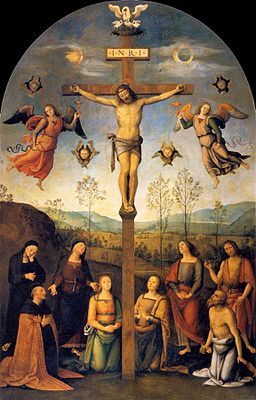The Via Crucis of Jesus Christ, like that of humanity in this age, is the thread uniting the meditations which will accompany the 14 stations of the Good Friday Way of the Cross this year, to take place at the Colosseum in Rome on 25 March. The texts were prepared at Pope Francis’ behest by Cardinal Gualtiero Bassetti, metropolitan archbishop of Perugia-Città della Pieve, Italy.
The cardinal explained to Vatican Radio that he was inspired by a painting by Perugino he saw in the monastery of Santa Maria Maddalena de’ Pazzi, showing the profound union between the Passion of Jesus and the passion of humanity.
The meditations of the Via Crucis, which always have the Word of God as their starting point, also refer to what is happening in the world, especially in places where there is suffering as a consequence of war and poverty, and where the dignity of the person is violated every day, as «Jesus lives His passion personally, but He also relives it in humanity.»
«Therefore», he adds, «I sought to interpret pain precisely in the light of God’s great love for humanity, as otherwise it has no meaning. Pain can be read only in the light of God’s love. And in the Year of Mercy it is clear that the horizon of my Via Crucis cannot be other than that of love and forgiveness».
The family is another recurrent theme in these meditations. Alongside the drama of the Virgin Mary who encounters her Son in the fourth station, the archbishop of Perugia recalls the dramatic situation of many families, of young unemployed people, of the dramas great and small faced by humanity and the Church today. He affirmed his intention to inspire reflection, starting from the closeness of the drama of the Passion of Christ to that of the passion of man today, on the need for forgiveness and reconciliation as in essence, «the Passion and the death of Christ are our reconciliation with God. However, we need this reconciliation personally, and also humanity and the Church are in need of it. Let us think also of the dramatic situation of today’s young people who lack meaning in life, let us think about economic uncertainty, of having to leave one’s own land because of war and poverty».
In the light of «Misericordiae vultus», the Bull with which the Pope convoked the Holy year, Cardinal Bassetti proposes synthesising the Passion of Jesus with the passion of the Church, of men, and of the world, reflecting in particular on the persecution of Christians in our time. «Unfortunately, in some areas of the world, many of our brothers are living this passion in their own flesh. The martyrs of the 21st century are undoubtedly today’s apostles, and as the Holy Father rightly says, when they kill you out of hatred of Christ, they do not ask if you are Catholic, or Protestant, or Orthodox. It is hatred of the faith of which you are a witness, the faith you express».
For the station of death on the cross, the cardinal chose a poem by the Servite friar and poet David Maria Turoldo (1916-1992), which describes Jesus’ absolute solitude and the abandonment of the Father, when He takes upon Himself all the suffering of all humanity. «And what strikes us all most is that Jesus goes up onto the Cross because He wanted to, and He could have avoided it; and He did not come down from the Cross, although He could have done so, because He was the Son of God».
«This year the Via Crucis of Jesus Christ seems in particular to be the Via Crucis of humanity», he concludes, «but all is then concentrated on the light of the Easter of Resurrection; this is the great message of hope that we continue to bear. Christ died and was reborn for our salvation and for that of the entire world».

Pietro Perugino Crucifixion
Author of Colosseum's Via Crucis Inspired by Perugino Painting
Artwork, and meditations, show profound union between the Passion of Jesus and the passion of humanity


